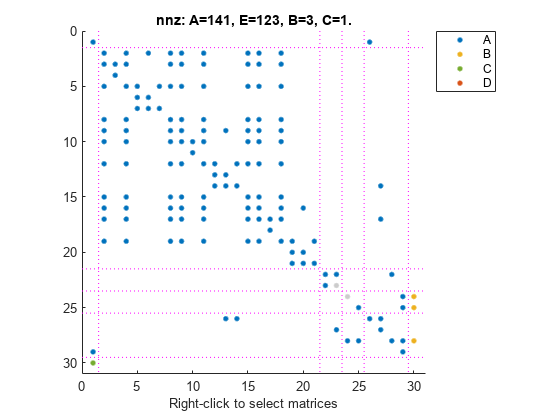sparss
Sparse first-order state-space model
Description
Use sparss to represent sparse descriptor state-space models
using matrices obtained from your finite element analysis (FEA) package. FEA involves the
concept of dynamic substructuring where a mechanical system is partitioned into components
that are modeled separately. These components are then coupled using rigid or semi-rigid
physical interfaces that express consistency of displacements and equilibrium of internal
forces. The resultant matrices from this type of modeling are quite large with a sparse
pattern. Hence, using sparss is an efficient way to represent such large
sparse state-space models in MATLAB® to perform linear analysis. You can also use sparss to
convert a second-order mechss model object to a sparss
object.
You can use sparss model objects to represent SISO or MIMO state-space
models in continuous time or discrete time. In continuous time, a first-order sparse
state-space model is represented in the following form:
Here, x, u and y
represent the states, inputs and outputs respectively, while A,
B, C, D and E
are the state-space matrices. The sparss object represents a state-space
model in MATLAB storing sparse matrices A, B,
C, D and E along with other
information such as sample time, names and delays specific to the inputs and outputs.
You can use a sparss object to:
Perform time-domain and frequency-domain response analysis.
Specify signal-based connections with other LTI models.
Transform models between continuous-time and discrete-time representations.
Find low-order approximations of large sparse models.
For more information, see Sparse Model Basics.
Creation
Syntax
Description
sys = sparss(A,B,C,D,E)
For instance, consider a plant with Nx states,
Ny outputs, and Nu inputs. The first-order
state-space matrices are:
Ais the sparse state matrix withNx-by-Nxreal- or complex-values.Bis the sparse input-to-state matrix withNx-by-Nureal- or complex-values.Cis the sparse state-to-output matrix withNy-by-Nxreal- or complex-values.Dis the sparse gain or input-to-output matrix withNy-by-Nureal- or complex-values.Eis the sparse mass matrix with the same size as matrixA. WhenEis omitted,sparsspopulatesEwith an identity matrix.
Input Arguments
Output Arguments
Properties
Object Functions
The following lists show functions you can use with sparss model
objects.
Examples
References
[1] M. Hosea and L. Shampine. "Analysis and implementation of TR-BDF2." Applied Numerical Mathematics, vol. 20, no. 1-2, pp. 21-37, 1996.
Version History
Introduced in R2020bSee Also
sparssdata | mechss | showStateInfo | xsort | full | getx0 | spy | Descriptor
State-Space (Simulink)


